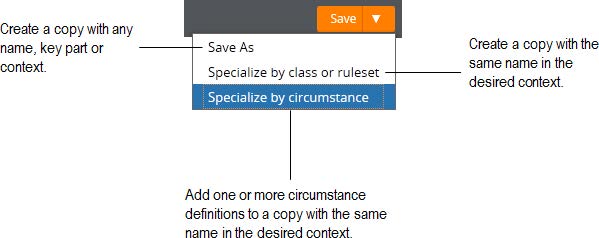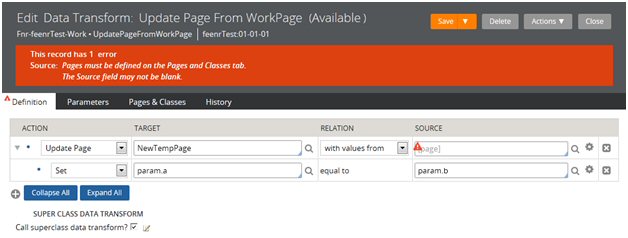Create, Save As, and Specialization forms
Valid from Pega Version 7.1.4
The familiar “New” and “Save As” forms have been streamlined to make record creation faster and more intuitive. You can easily target a specific layer in your application stack, interactively define the record’s configuration and select only those circumstance definitions that make sense for your use case.
While the underlying behavior for creating a record is not new for this release, the redesigned UI of these forms and new defaulting strategy for fields is worth noting:

To launch these forms, use one of the new options found in the action area of the form header:

Note that not all record types support the ability to specialize by circumstance.
For more guidance on how to use the Create, Save As and Specialization forms, please refer to: Intuitive record creation and specialization
Redirect users to logout screen
Valid from Pega Version 7.1.4
New applications built in Version 7.1 will automatically redirect users to the PRPC login page upon logout.
A new template, Web-Session-Return-Template, has been added, to allow developers to customize their applications to redirect users to a logout page, if they wish. This template can be copied to a ruleset visible to unauthenticated requestors (via node configuration) and used to override Web-Session-Return.
Source field not displaying in data transform
Valid from Pega Version 7.1.4
On the Data Transform rule form when using the Update Page action, if the Relation value is updated to “with values from”, the Source field will not be displayed.
(Note that for existing data transforms where the Source field has already been completed, this situation should not occur.)
Workaround
- Below is a data transform that has been configured to use Update Page.

- If a user were to choose an alternate source by updating the ‘with values from’ Relation value, they would not be prompted to provide a page name in the Source field.

- At this point, to be able to enter the Source page value, the user has to save the rule, which results in an error because the source page value is blank. This causes the field to appear.

- Once the field has appeared, the Source page value can be provided, and the form can be saved successfully.

Core Engine
Valid from Pega Version 7.1.4
This release contains fixes related to clipboard and declarative features, including data pages and autopopulate.
- A rule may be changed using Private Checkout, and then checked into a higher RuleSet Version for that RuleSet.
- Agents may now use a 24-hour time period for scheduling, as well as a 12-hour time period (which required the selection of AM or PM).
- Caching and performance have been enhanced.
- Declare expressions will work with embedded page lists when creating forms.
- Mandatory parameters on a data page can handle blank values.
- Properties may be auto-populated using a reference property which is created with a Property-Ref method in an activity.
- System will use "private edit" rules in developer's personal RuleSet when that rule overrides the "standard" rule available to all.
- The Page-Remove method will now remove Data Pages at the Thread level and the Requestor Level.
- When copying a page using the "Set" action on a data transform, the Declare Indexes defined on that data will be updated.
- When creating a data page, the Reload Once per Interaction checkbox can be checked to set the refresh strategy.
Designer Studio
Valid from Pega Version 7.1.4
Many refinements to the Designer Studio were made around performance and user experience. Based on feedback, we have made a number of bug fixes and strategic improvements that improve the overall user experience.
- The Developer Portal connects to the PDN's RSS feed without needing a DigiCert certificate for validation. The RSS feed is just headlines; to open and read any of the articles, users will still have to log into the PDN.
- Expression Builder has been enhanced to work with IE8.
- New applications built in Version 7.1 will automatically redirect users to the PRPC login page upon logout. A new template has been added, to allow developers to customize their applications to redirect users to a logout page, if they wish.
- Performance improvements were made when saving and validating rules.
- Performance of the Guardrails Dashboard has been improved.
- The display of circumstanced rules in Application Explorer has been enhanced.
Reporting & Data
Valid from Pega Version 7.1.4
This release fixed many existing unlocalizable elements in 7.1 reporting interfaces (The Report Viewer, Report Editor, Chart Editor, and the Report Browser) and now they are fully localizable. Changes were made to make Listview, summaryview, and report viewer display possible WCAG 2.0 level A and AA support.
- Parameters may now be used in a sub-report join condition.
- Report Definition localization has been enhanced.
- Standalone ListViews with embedded SmartInfo have been improved to resize appropriately when the SmartInfo section is expanded.
- The data section of a report will now display in all of the available space when a fixed header option is selected.
- When localizing a listview with filters, tool tips are translated.
Consistent search experience in App Studio
Valid from Pega Version 8.5
Pega Platform™ now supports a unified search mechanism in App Studio. Instead of manually locating a single item, such as a case type, a channel, or a data object, you can simply use the Search option in the navigation pane. You can also use Search in case types and personas landing pages, to conveniently access the information that you need, for example channels and case types associated with a persona.
For more information, see Plan your Microjourneys more conveniently in an improved Case Designer (8.5), Creating a Microjourney for customer success.
Automated project estimation in App Studio
Valid from Pega Version 8.5
App Studio now supports estimating projects in an intuitive and automated way, so that you can plan your work with greater efficiency and accuracy. Estimations include the number of hours that you will need to deliver an application, based on multiple factors such as the delivery methodology, the number and complexity of features to implement, and the number of teams involved. After you provide the required data, the project estimator calculates the expected duration of application development. To share your project estimates outside Pega Platform™, for example with your stakeholders, you can also export estimates to an .xlsx file.
For more information, see Estimate projects automatically in App Studio (8.5), Estimating application development.
Enhanced application inventory to support features
Valid from Pega Version 8.5
Now the application inventory in App Studio also includes features that represent elements of your application to implement, such as language packs, along with personas and data objects. The inventory provides the option to add new features or reuse existing features from built-on applications. With the enhanced inventory, application development planning and tracking is faster and more intuitive because you can now easily check the features that your development team needs to implement. For greater clarity, the inventory supports different methods of grouping features, for example, by release or complexity.
For more information, see Managing application inventory.
Enhanced Case Designer in App Studio
Valid from Pega Version 8.5
For greater clarity when visualizing your business processes, App Studio now has an improved Case Designer. In Pega Platform™ 8.5, every persona displays a list of associated channels, and every data object lists associated systems, instead of showing multiple entities for different channels or systems. Additionally, for better distinction every channel and system displays a unique icon. To fully convey your business process using just one screen, Case Designer now also supports visualizing attachments required for your microjourney, as well as creating draft associations between personas and channels.
For more information, see Plan your Microjourneys more conveniently in an improved Case Designer (8.5), Creating a Microjourney for customer success.

